I think we can all agree that it’s better to load your gun proactively, and not reactively, when you’re using it to defend yourself. Choosing when to reload your gun is preferable to being forced to reload your gun without notice, because it went dry. That guy Murphy will always make sure to spring the surprise on you at the very worst time . . .
That said, I’m reminded that battle plans rarely survive first contact with the enemy, and what we’d like to do is not always possible once the clock is set in motion.
That “Tactical Loading” Thing
I’ve written here before about the classic, “tactical reload” procedure for topping off revolvers, and I have to say I’m not really a fan of it. I recognize that plucking spent cases from a partially depleted cylinder and replacing them with live rounds was a staple in LE and competition circles for many decades, but I never thought the exercise was very realistic or useful. You could certainly pull it off in a low stress environment (training), but I never thought the procedure was stress-resistant enough to rely on it for serious purposes, and always felt it could create more problems than it solved. A neat range trick, maybe, but not very useful for combat.
Honestly, if a revolver shooter encounters that proverbial (near-mythical?) “lull in the fight” that trainers like to wax so eloquently about, and wants to bring his gun up to full capacity, I think there are better ways to do it than to pluck spent cases and replace them with live rounds.1
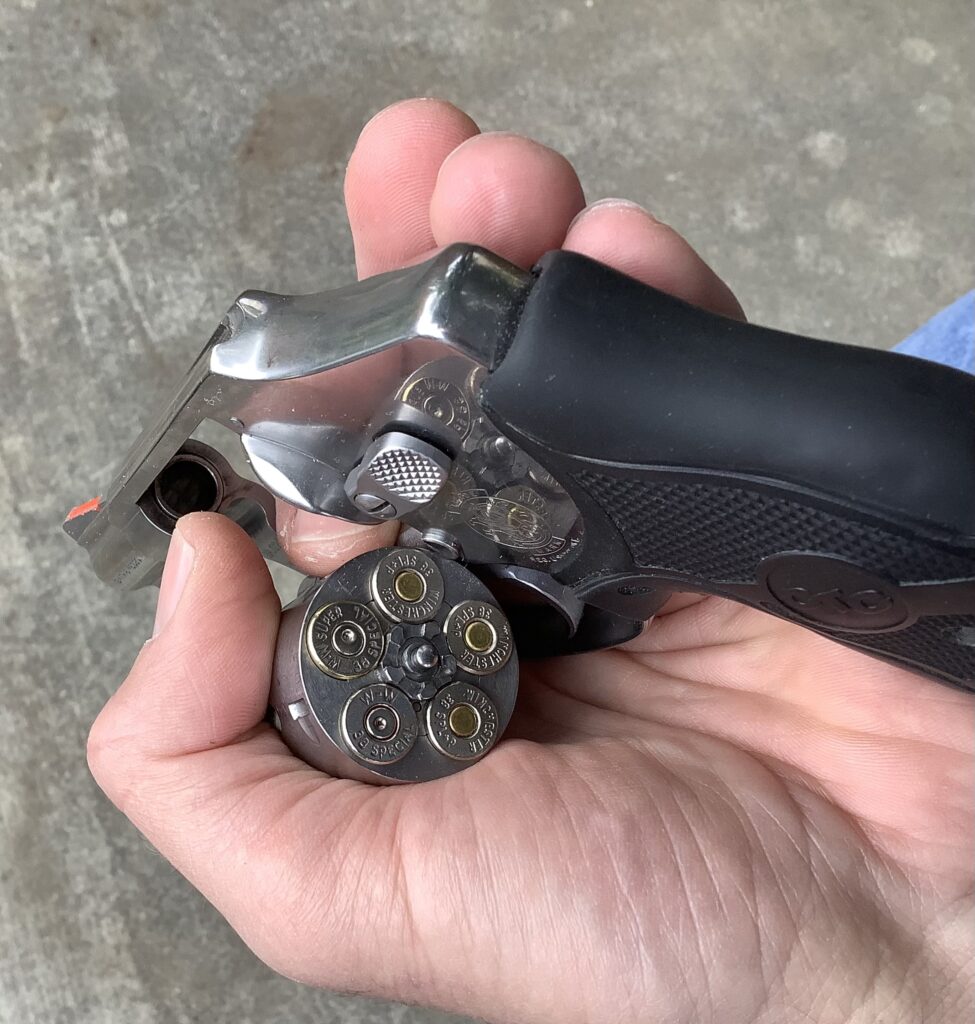
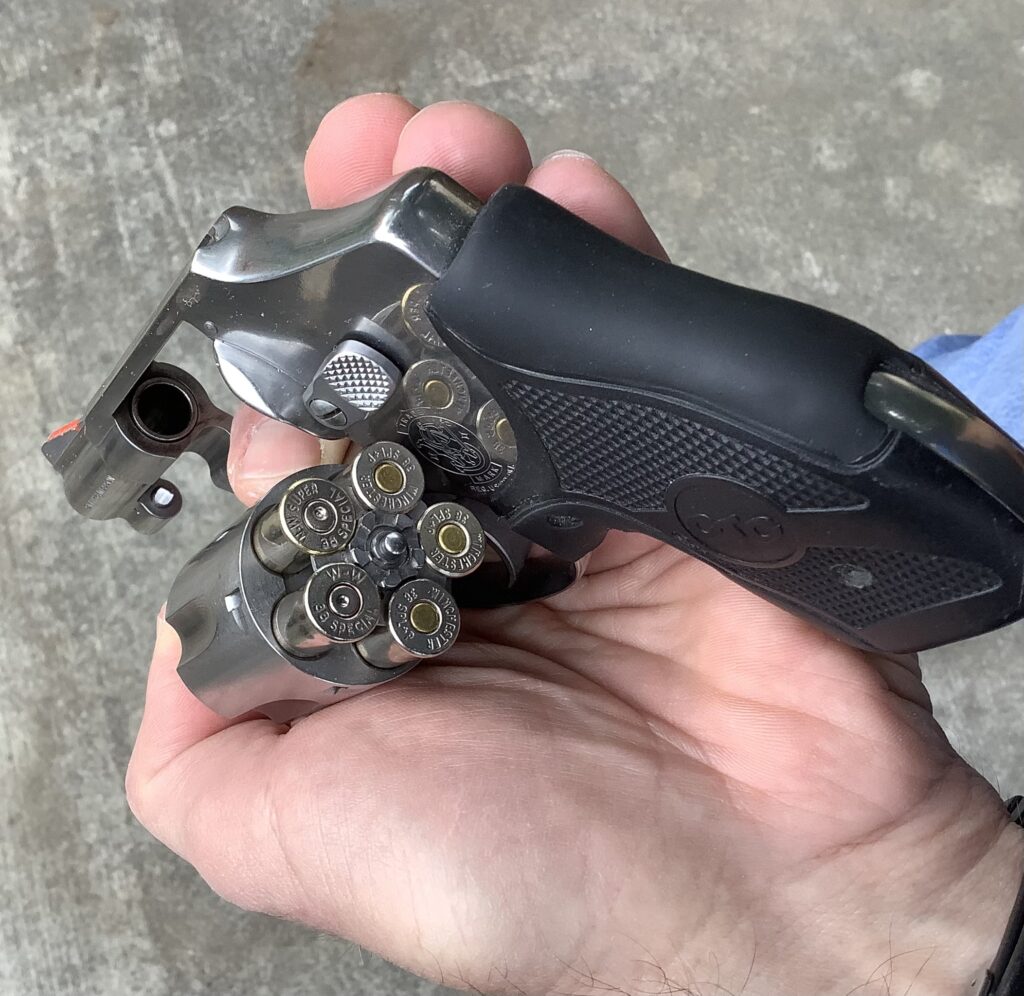
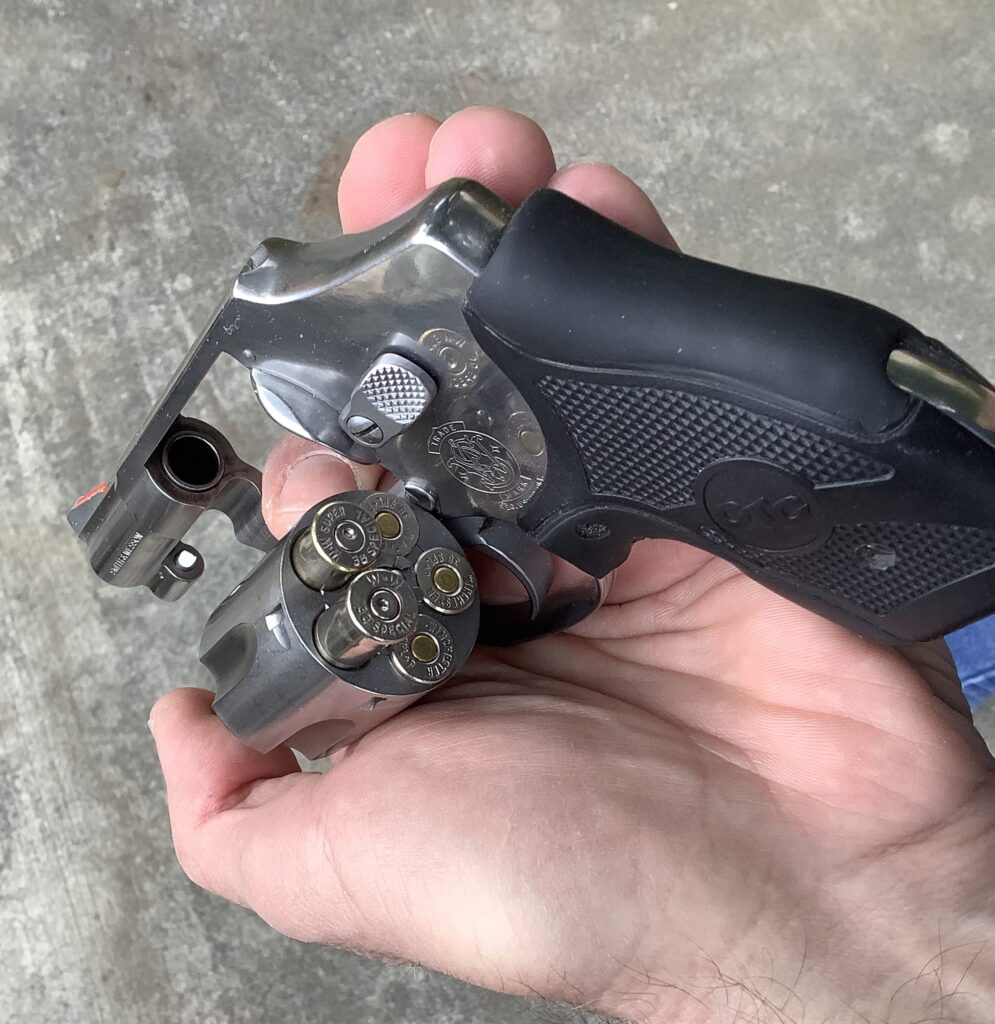
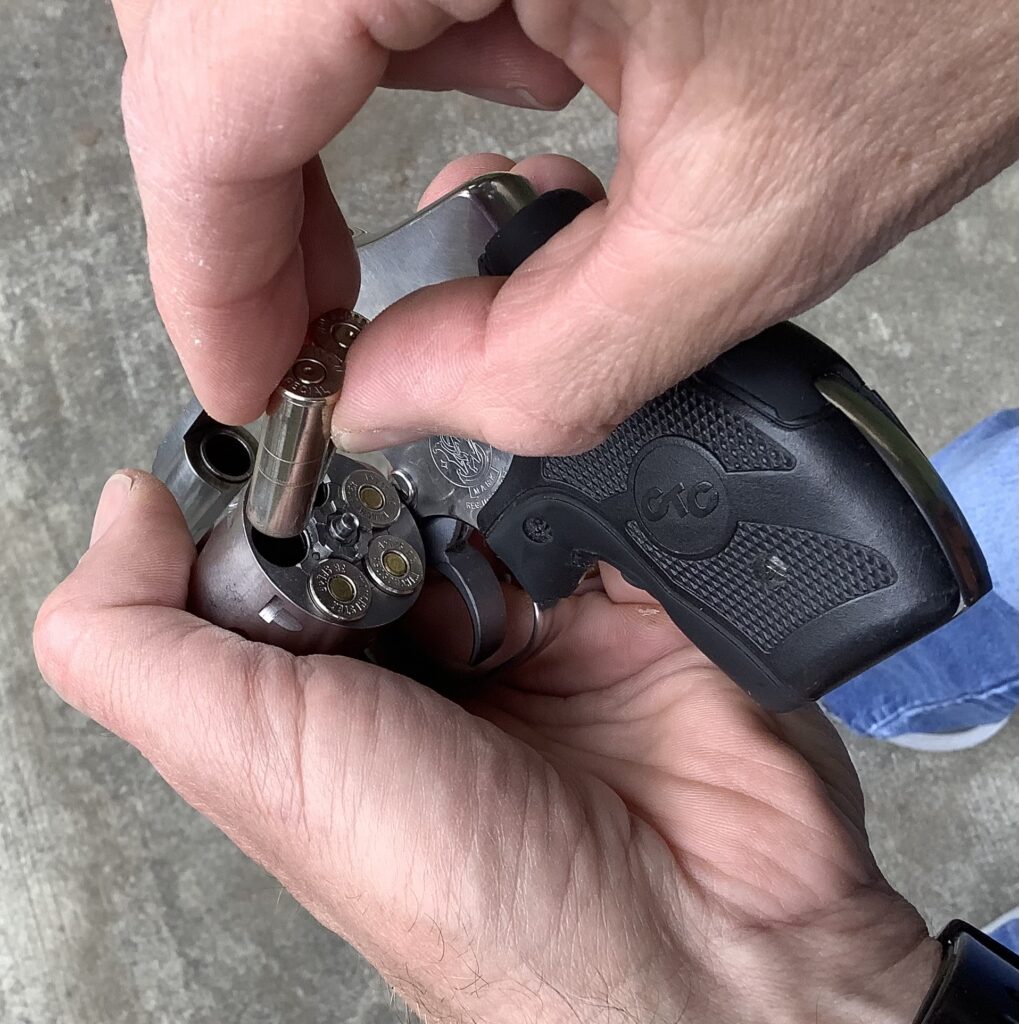
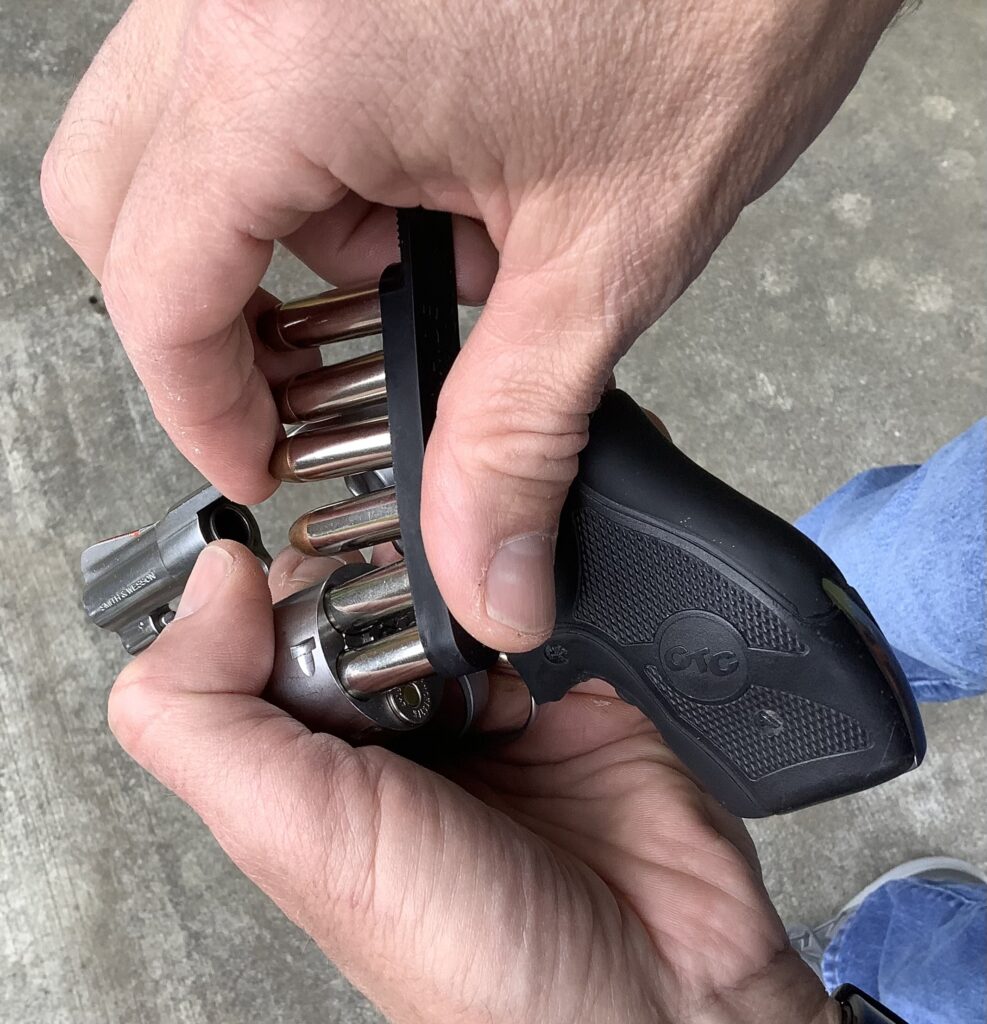
My favorite technique, as a guy who frequently carries his spare revolver ammo in speedloaders, is to simply unload the gun, then reload the gun–dump everything out, and fill the empty chambers with new ammo. This procedure is about as fast, simple, and reliable as it gets, and it’s probably the method you’ve practiced the most, too. If time permits, you can pick up the live rounds you dumped on the ground after your gun is back up. If your tactical situation has deteriorated while you’ve been working on your gun, forget about the ammo on the ground–finish your fight, and police up the live rounds later.
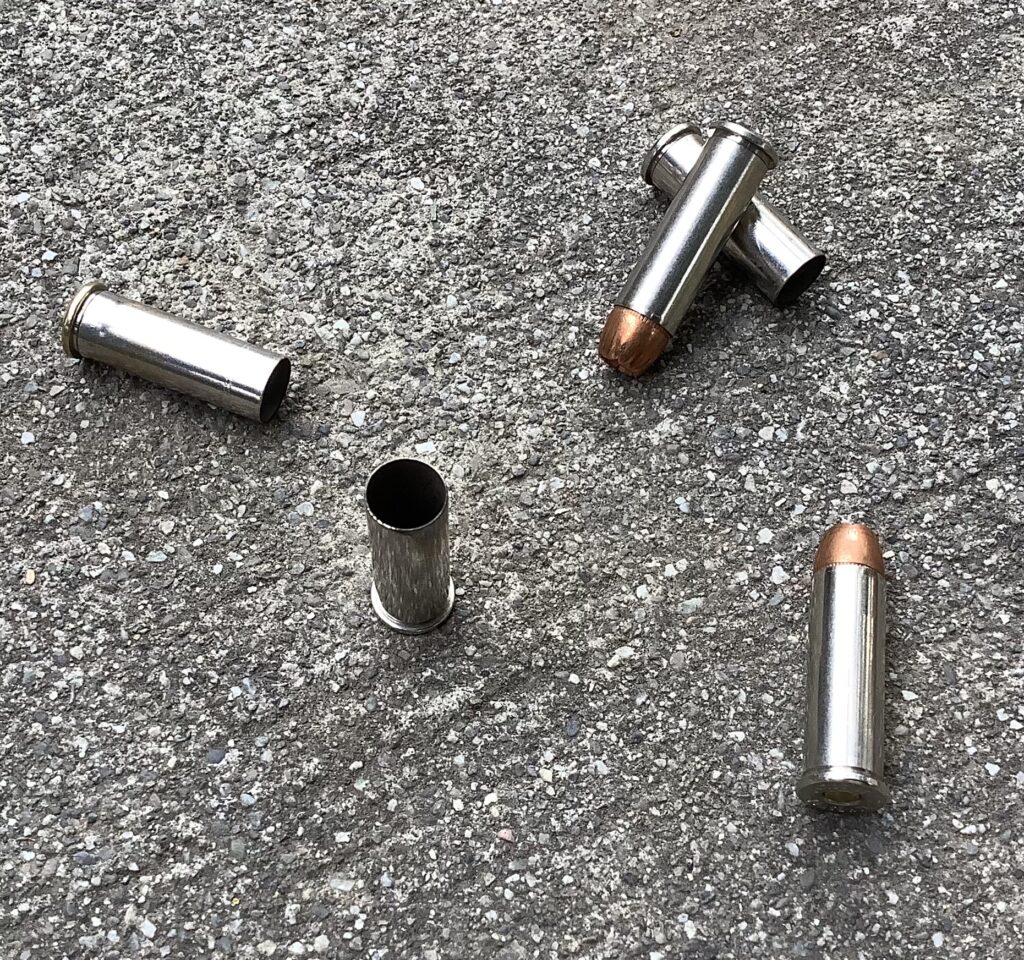
That same technique works pretty well with a strip loader, too. I’d actually rather dump everything and have to refill five or six empty chambers with a strip loader, than navigate the traditional dance of lifting a few spent cases, plucking them out, and filling the empty chambers with new rounds. The former technique is more resistant to the debilitating effects of stress, and it’s probably just about as fast. It’s certainly faster than trying to recover from screwing up the more complex “tactical loading” procedure, especially if you manage to get a case or round stuck underneath the extractor star while you’re futzing about. Doom on you, if that happens during a fight.
The “reverse tactical reloaD”
For those who just can’t stand the idea of dumping live ammo on the ground, and insist on using a technique where the live ammo is actively retained, RevolverGuy Dean Caputo offers a useful alternative that he jokingly calls the “reverse tactical reload.”
In the “reverse,” you open the cylinder, then raise the muzzle, with your hand cupped underneath the rear of the cylinder. The fired cases will almost always stay in place, because they’ve expanded against the walls of their chambers, but the unfired rounds should quickly spill into your cupped hand. Pocket the live rounds, then work the extractor rod to empty the spent cases from the chambers in the normal fashion. Reload the gun with your fresh loader, and you’re back in the fight.
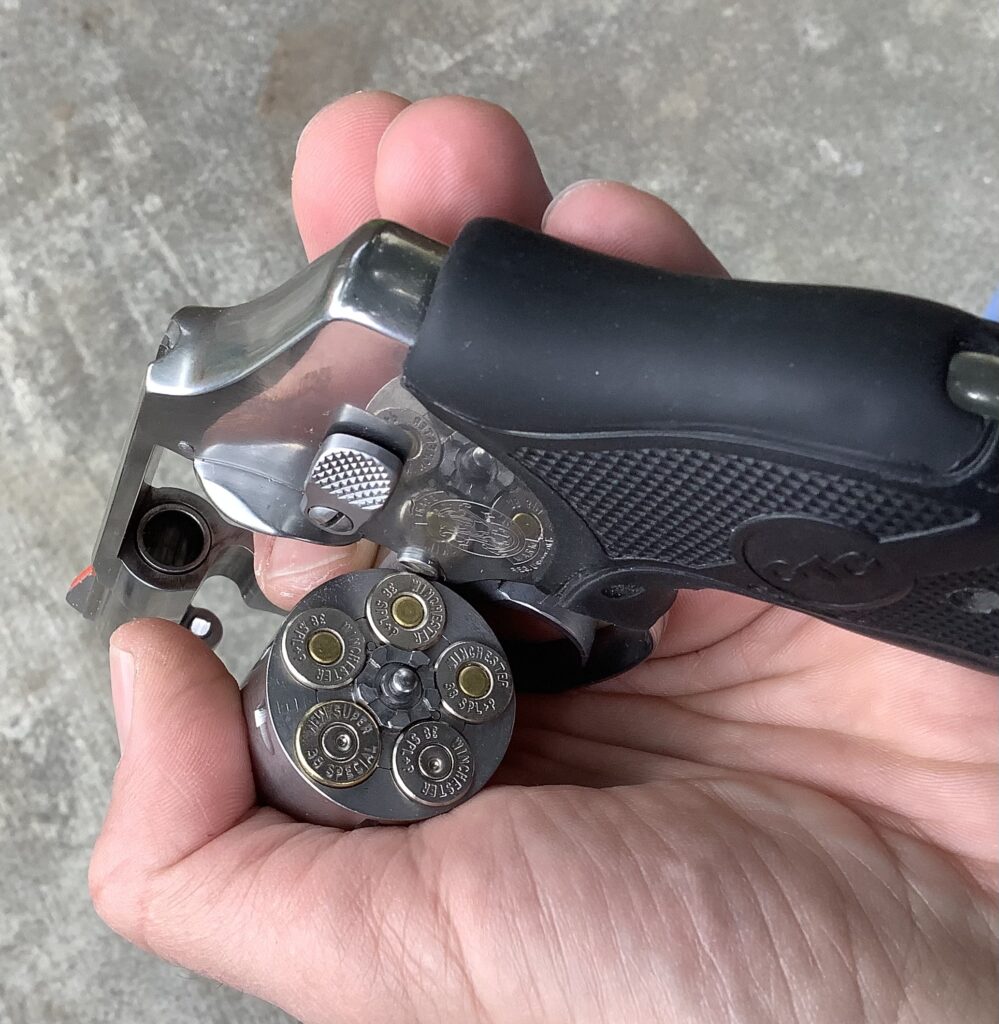
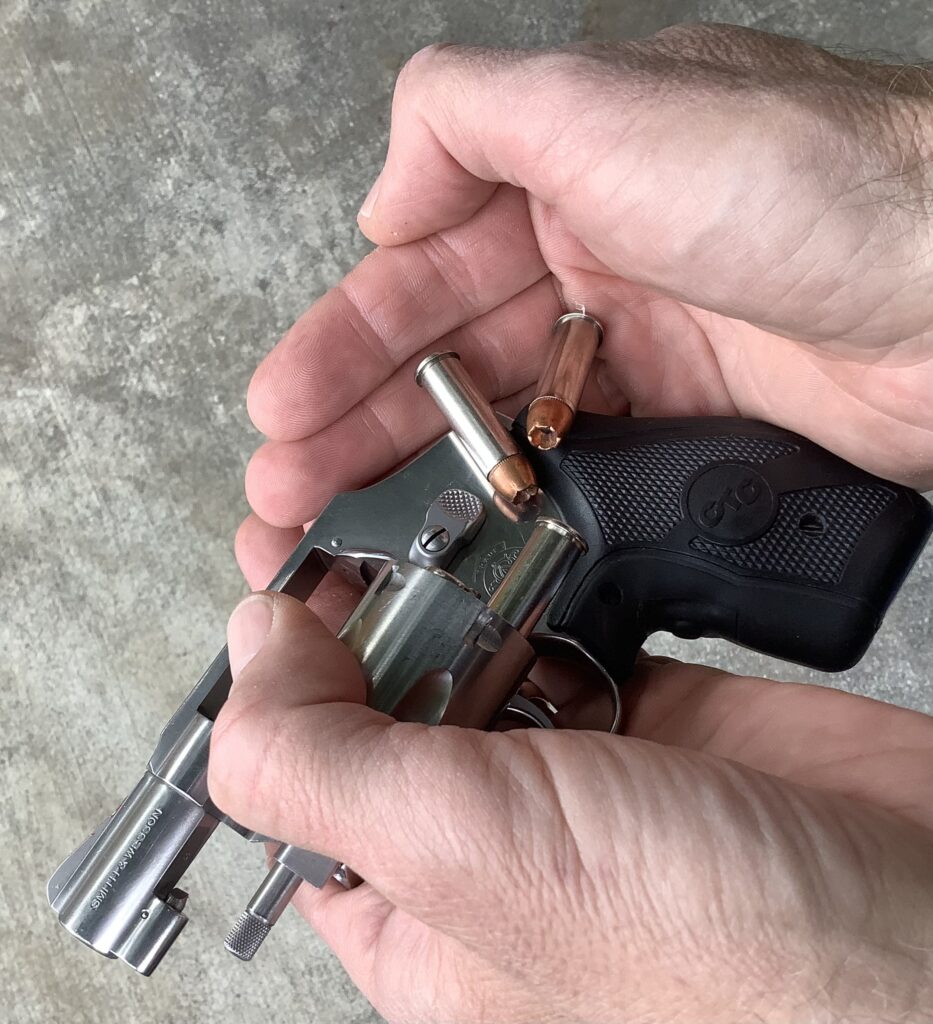
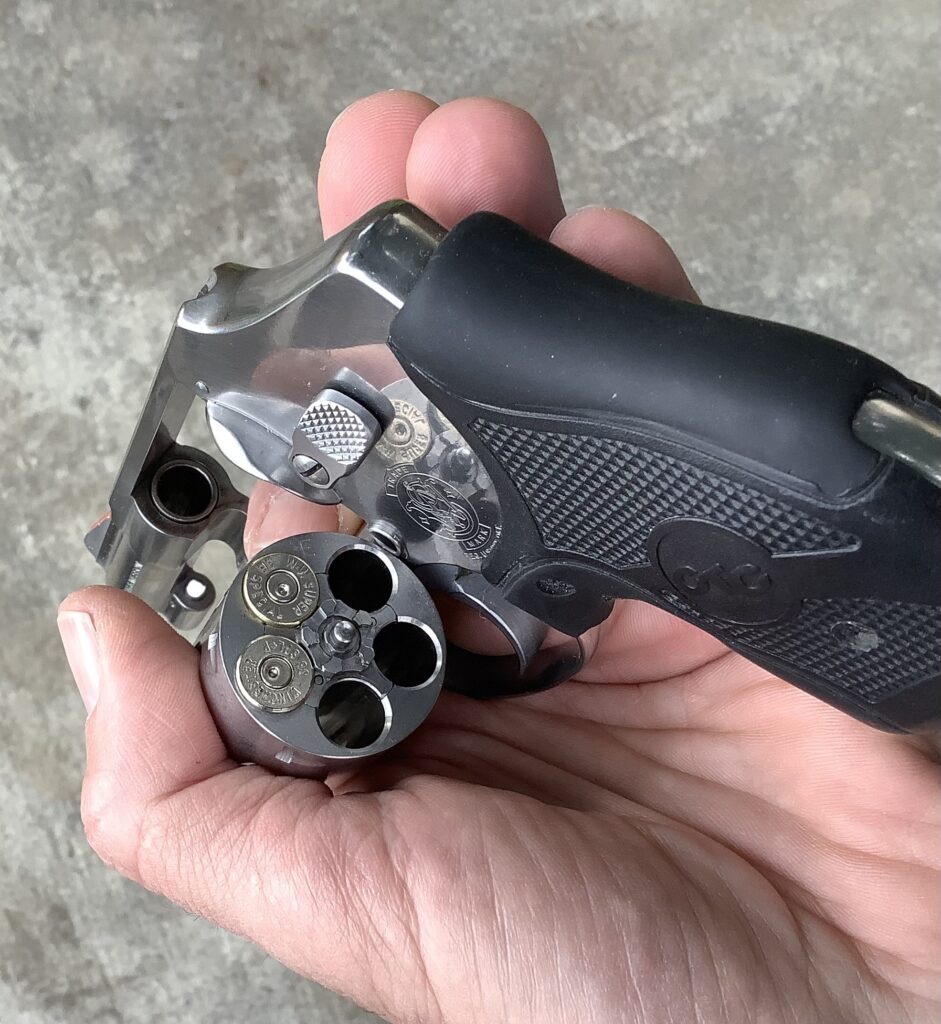
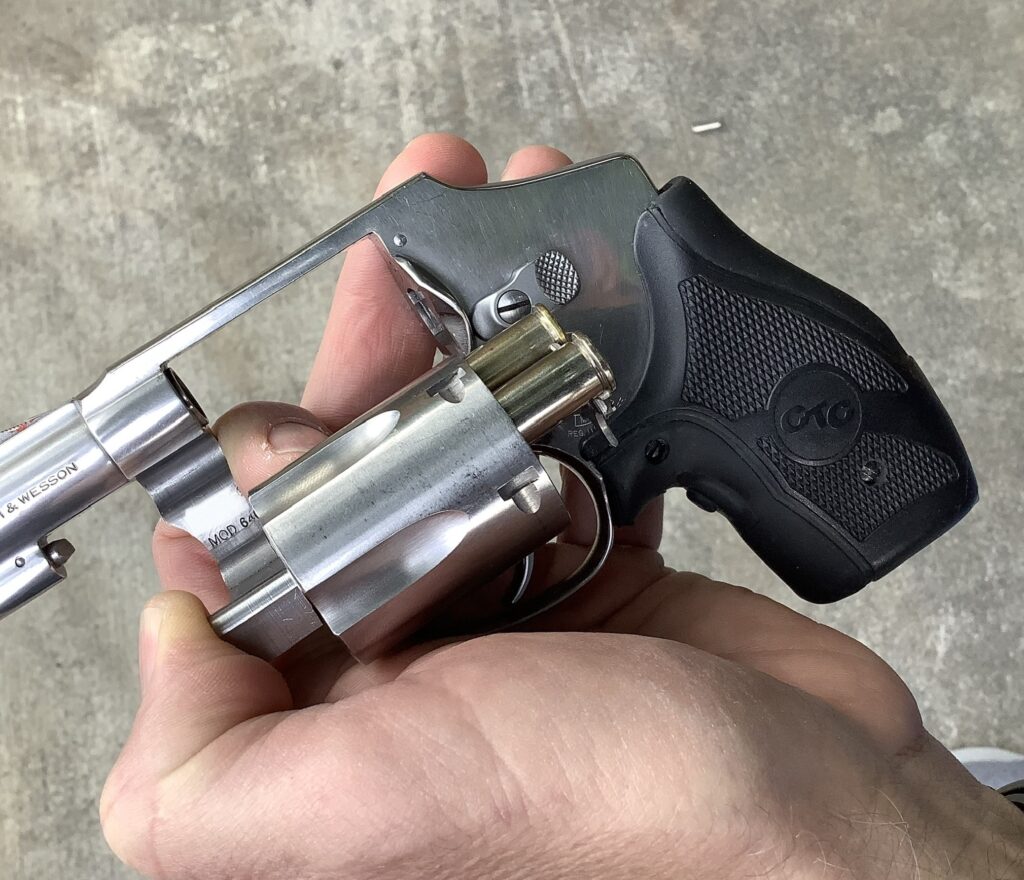
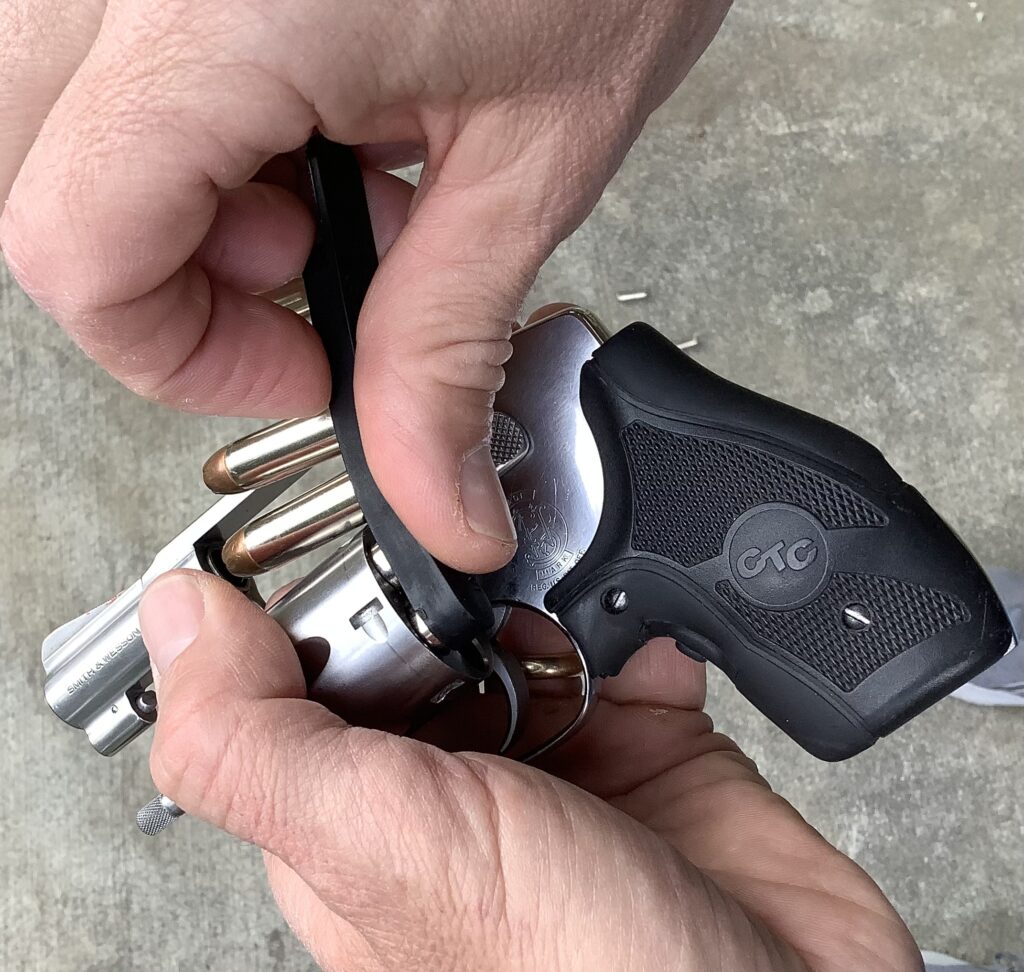
I think the “reverse” is a better alternative to the traditional method for conducting a tactical load on a revolver, but I still think it’s better suited for low stress, administrative operations than for in extremis situations.
something more useful
If we’re really concerned about keeping the gun loaded while engaged with the enemy, I think it would be more useful to focus on emergency (reactive) reloads than tactical (proactive) reloads.2
It seems to me that we’re much more likely to run our five or six-round gun completely dry, and need to get it back into the fight quickly, than to have that “lull in the fight” where we can top off a partially depleted gun with a tactical reload. The former seems like an unfortunate reality, the latter more like wishful thinking.
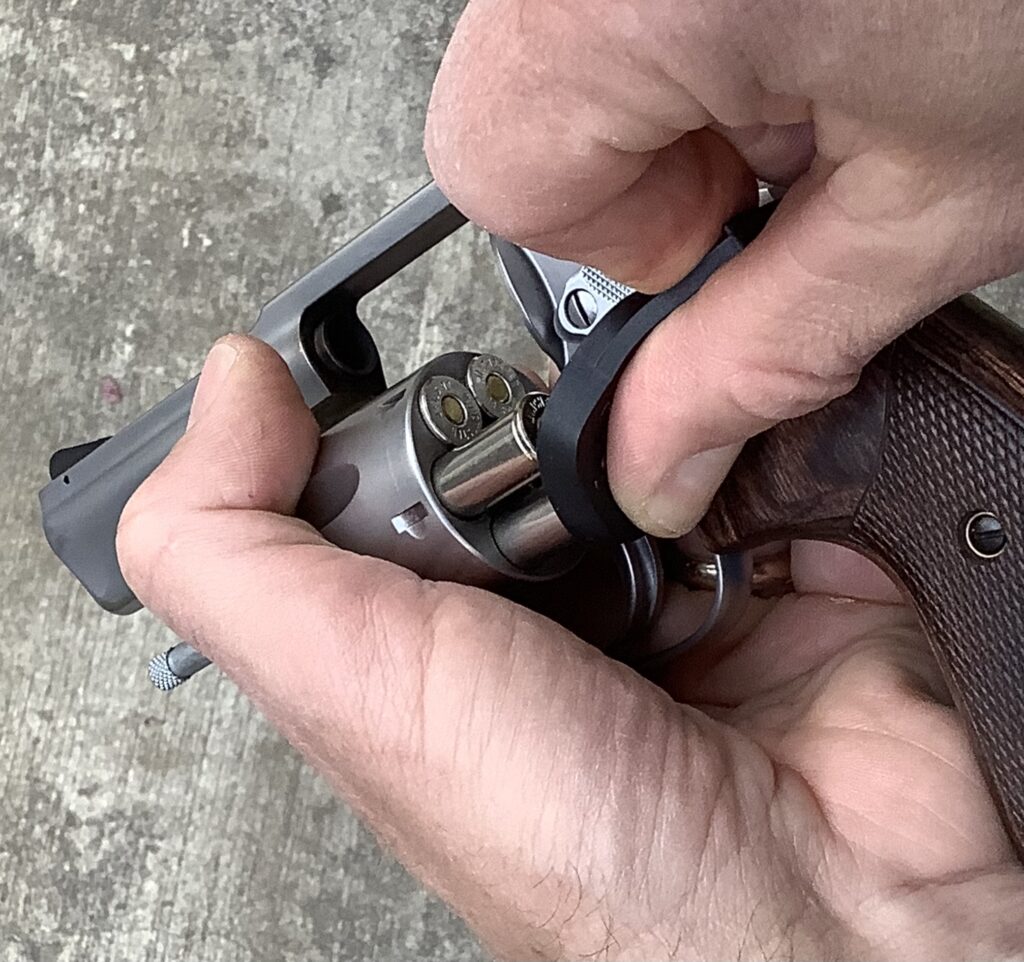
If your spare ammunition is carried in speedloaders, then the task is rather straightforward when your gun runs dry–you simply need to reload it. Get the spent cases out, and the fresh ammo in. We’ve discussed a variety of methods to accomplish that here in these pages, to include such techniques as the Universal Revolver Reload and Stressfire Reload.
If your spare ammunition is carried in a strip loader, a 2x2x2 pouch, belt loops, or just loose in a pocket, then you have the option to consider a “partial reload” when your gun runs dry in the middle of a fight.
the argument for the partial reload
We’ve previously talked about partial reloads before, but for those who missed the conversation, a partial reload is just what it sounds like–a reload in which the cylinder isn’t loaded up to full capacity, but instead is loaded with just a few rounds before the cylinder is closed.
The whole premise of the partial reload is that it’s better to get back into the fight quickly with just a few rounds in the gun, than to delay your reentry into the fight, because you wanted to load the cylinder to full capacity, first. It’s an exercise in time and risk management that prioritizes speed over capacity, minimizing your down time over volume of fire.
Friend, and world-class instructor, Wayne Dobbs likes to remind us that we’ll probably run out of time in a gunfight before we run out of ammo, and I think he’s absolutely right. I like the partial reload a lot, as a way to deal with this tactical reality.
The partial reload begins with emptying the cylinder, just as you would in the first step of any emergency (reactive) reload.
Once the cylinder has been emptied, the shooter will load one or two chambers, then close the cylinder in a manner that the loaded chambers will be the first to advance under the hammer when the trigger is pulled. The goal is for the first trigger pull to result in a “Bang,” not a “Click.”
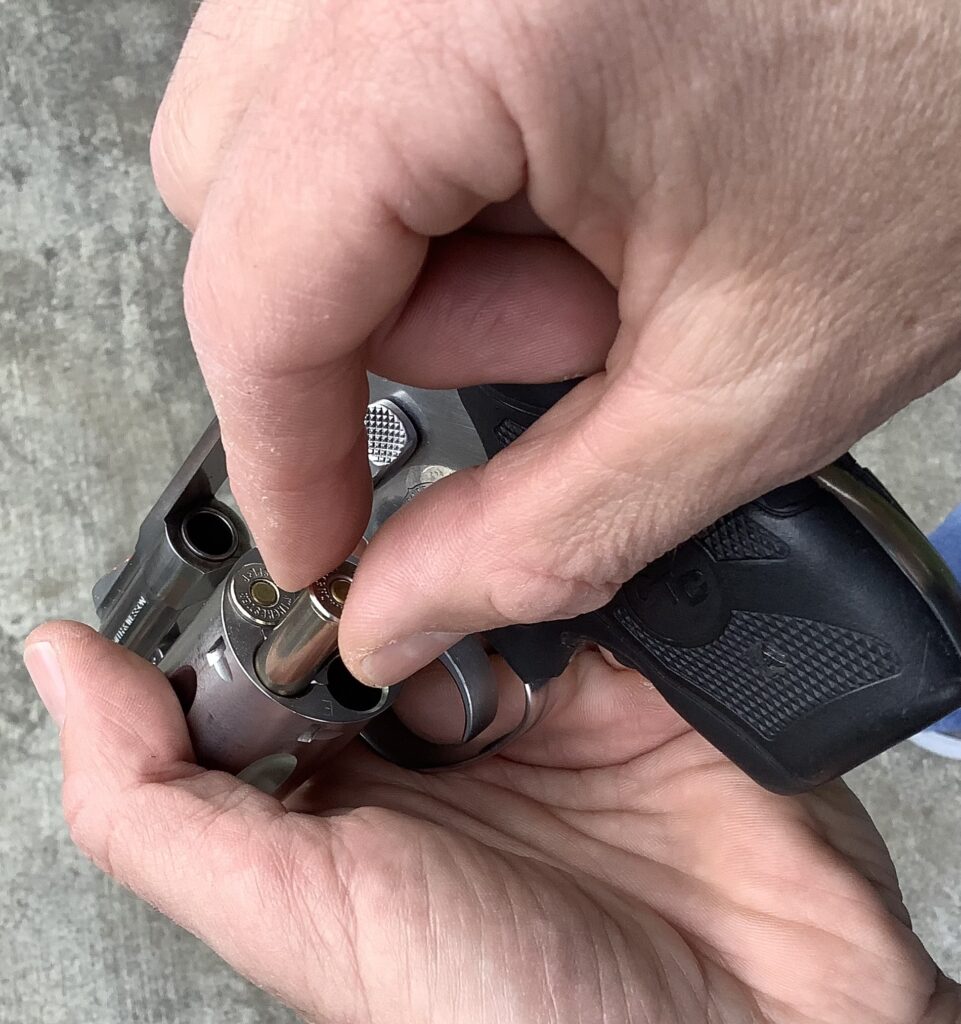
Loading just one or two rounds before closing the cylinder gets the gun back into action faster than if we tried to feed all the chambers before closing up the gun. Let’s face it–if you’re loading from loops, strips, a 2x2x2 pouch, or with loose rounds from a pocket, it’s gonna take a while to fill all those chambers. While you’re doing that, your enemy is free to attack you. Wouldn’t it be advantageous if you could fire a round or two at him sooner, rather than later? You might just be able to put an end to it all, before his bullet finds you.
This drama isn’t just theoretical. We’ve seen it play out before, in gunfights like Newhall, Miami and the Scott Gadell shooting, where lawmen were either killed or injured while trying to reload their empty revolvers.
In Newhall, wounded Officer James Pence had just completed filling his cylinder to full capacity, using his dump pouch, and was about to close up his gun and return to the fight, when his opponent killed him at close range. Had he loaded just one or two rounds, then resumed shooting, Pence may have been able to shoot his opponent as he was flanking his position.
In Miami, Agents Gordon McNeill and John Hanlon were both grievously wounded while trying to get rounds into their empty guns. In McNeill’s case, he got three live rounds into his gun from his pouch, and tried to get back into the fight with this partial load, but couldn’t get the cylinder closed, because it was fouled with blood and bone from his shattered gun hand. Unfortunately, he was shot and paralyzed before he could access a different gun that worked.
Agent Hanlon got two rounds into his gun from his pouch, and it appears he was trying to load the other three chambers before he was shot at close range.3 It’s regrettable that he didn’t get to fire the ones he’d already loaded, before he was hit, himself.
As the cylinder turns
When we’re doing a partial reload, the first thing we need to consider is which direction our cylinder turns when the gun is being fired.
In most Smith & Wessons, the cylinder turns counter-clockwise, when viewed from the rear. The same is true for revolvers from Ruger, Kimber, and Taurus, as well as the AL-series revolvers from Rock Island Armory/Alfa-Proj that we’ve reviewed in these pages.
In Colt revolvers, the cylinder turns clockwise, when viewed from the rear. The same is true for the Smith & Wesson M&P Bodyguard 38 (because keeping things consistent across the brand would have made too much sense) and the Armscor M200-series revolvers.
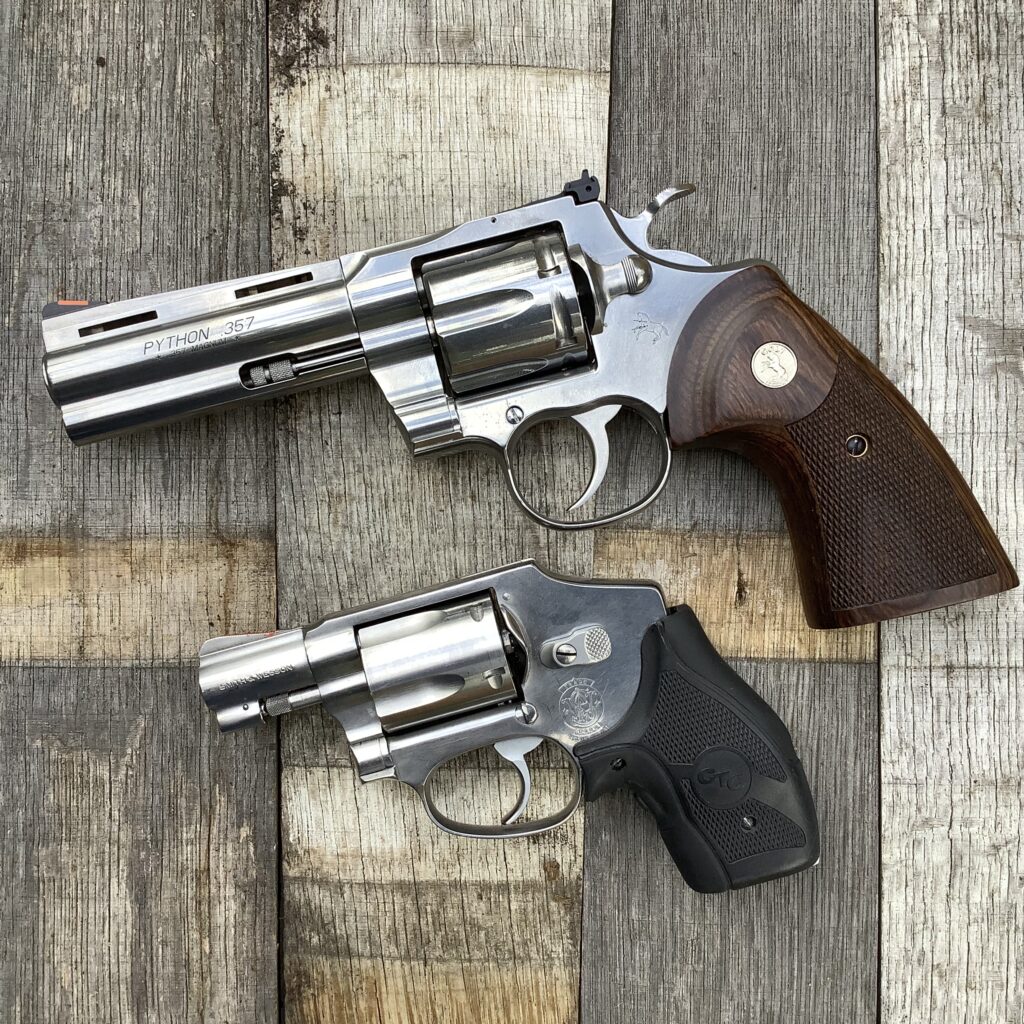
If you’re ever in doubt, and need a reminder about which way your cylinder turns, you can use the cylinder stop notches on the port side (left side, as viewed from the rear of the gun) of the cylinder to help answer the question. The notches are roughly T-shaped, with the raceway to the notch forming the post of the “T,” and the rectangular notch forming the crossbar of the “T.” Treat the “T” like it’s an arrow, with the bottom of the post pointing in the direction of rotation. On S&Ws, the “T” is upright on the port side of the cylinder, so the cylinder will rotate downwards, or counter-clockwise. On Colts the “T” is inverted on the left side of the cylinder, so the cylinder will rotate upwards, or clockwise.
Finding the right chambers
Since all of these guns have cylinders that swing out to the left, the best chambers to target for your partial reload are the chambers in the region from about 8 O’Clock to 11 O’Clock, because these are the chambers that are easiest to access. The approach to the remaining chambers will be blocked by the frame or grips to some degree, and will be harder to fill, so working on the outboard chambers will be your best option.
A useful technique for guiding your cartridges into these chambers involves the concept of proprioception, or an awareness of body position. To explain, you know where your body parts are in space without having to look at them, and you have the ability to bring these parts together without looking, too. Consider the job of clapping your hands, for example. You don’t need to look at your hands to locate them, and visually track their movement, to bring them together. Even with your eyes closed, you can just move them from wherever they are, and bring them together in a clap, because you have the gift of proprioception.
We can use this same body awareness to help load the gun. How? Well, we can use your natural ability to join the index finger on one hand with the thumb on your other hand. That is, the fingers of your loading hand are going to naturally find the thumb of your support hand, as it holds and indexes the cylinder.
Let’s break it down.
For right-handed shooters, with the gun in your left hand, the cylinder will be held in place with a ring formed by your thumb and fingers (as in the Universal Revolver Reload), or cradled in your palm, with the extractor rod poking through a “V” in your fingers (as in the Stressfire Reload). In each case, the thumb will naturally rest on the outside of the cylinder, around 9 O’Clock to 10 O’Clock, adjacent to the chambers you would like to fill.
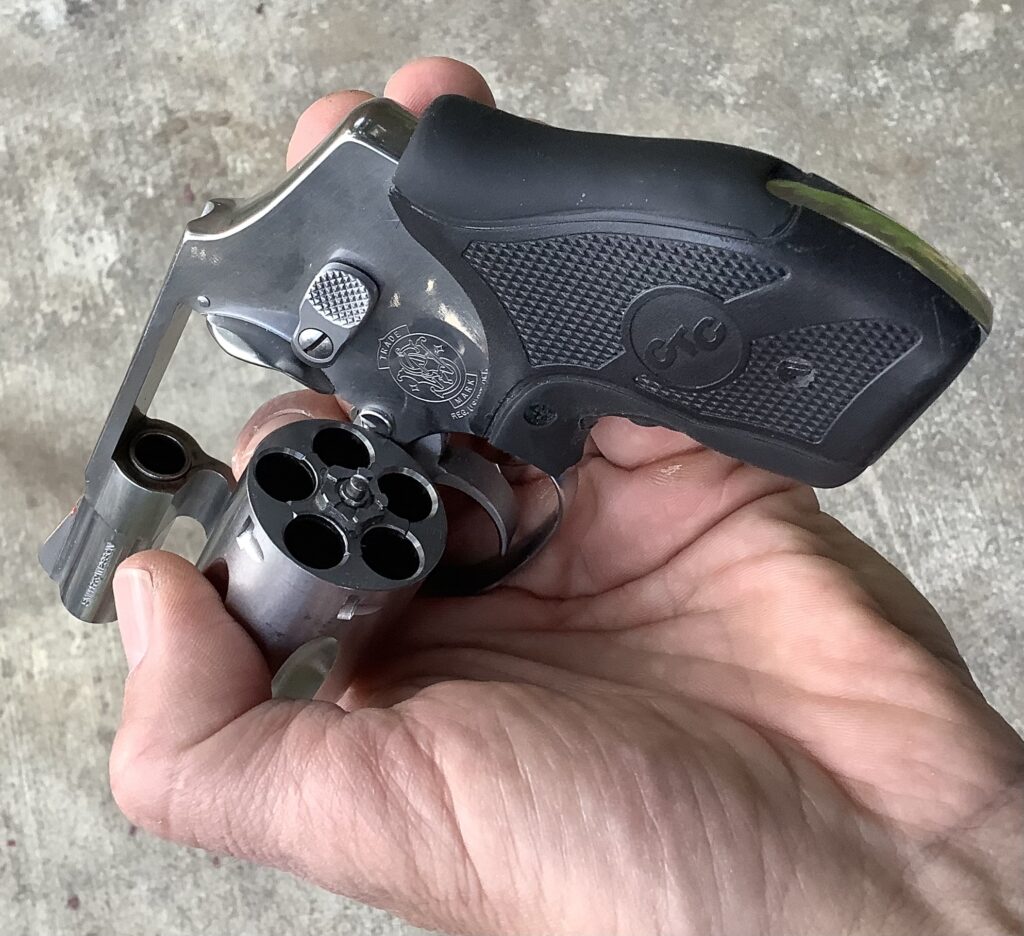
If you have a fluted cylinder (like Colts, and most S&Ws and Rugers) it will be natural for the thumb to find one of the flutes and rest in it. If your cylinder has flats (like the Kimber K6s), your thumb will naturally find a flat. These flutes and flats ride in-between chambers, in line with the cylinder walls, so with your thumb on one of them, you know that it’s straddling a pair of chambers in the cylinder.
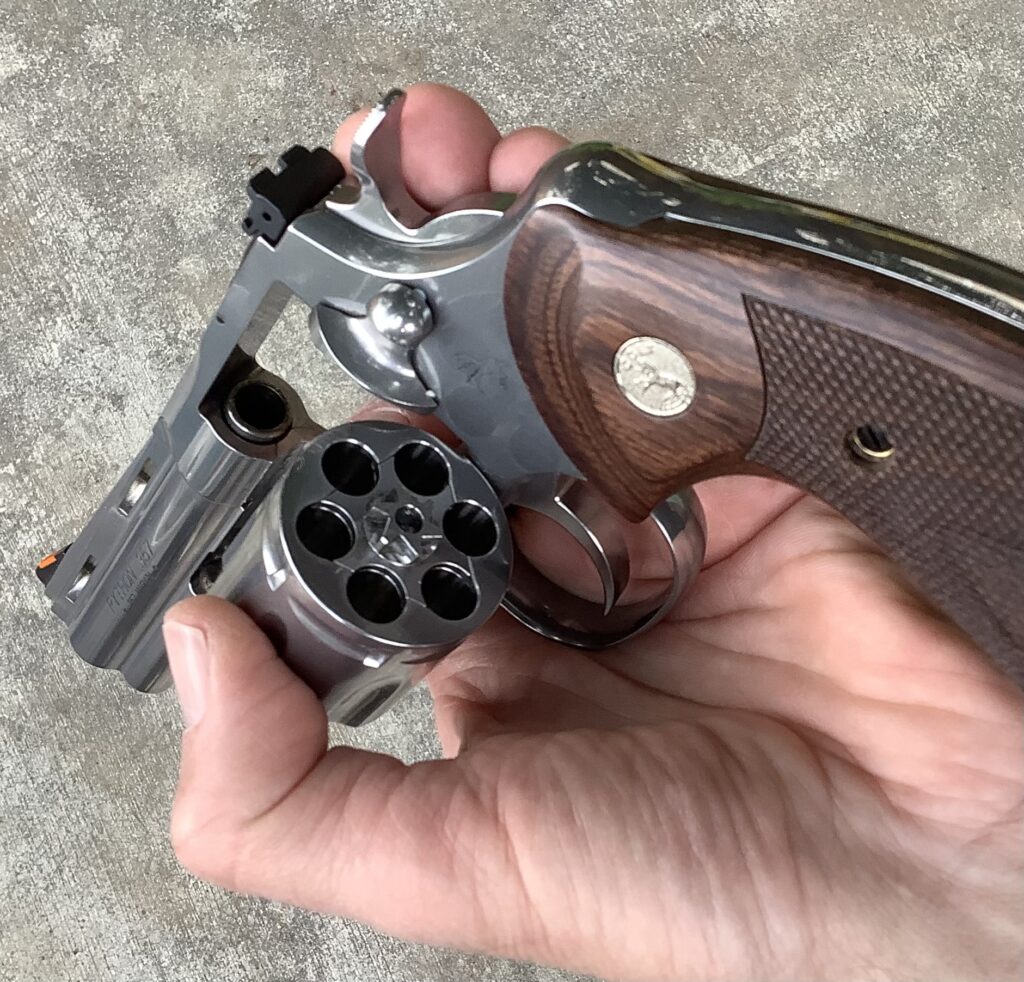
If you pinch a pair of cartridges between your thumb and fingers (as you would when drawing from a 2x2x2 pouch or loops, or from a pocket of loose cartridges), and hold them inline with your fingers, you can guide them into the chambers by mating your fingertips with the thumb that’s holding the cylinder. With a pair of cartridges being held side-by-side in your primary hand fingertips, if you aim at the support hand thumb, the cartridges will probably split the cylinder wall and line up pretty nicely with the chambers. If you miss, it won’t be by much, and you’ll be able to find the chambers by rolling the cylinder just a touch with your thumb, or jiggling your fingertips, or a combination of both.
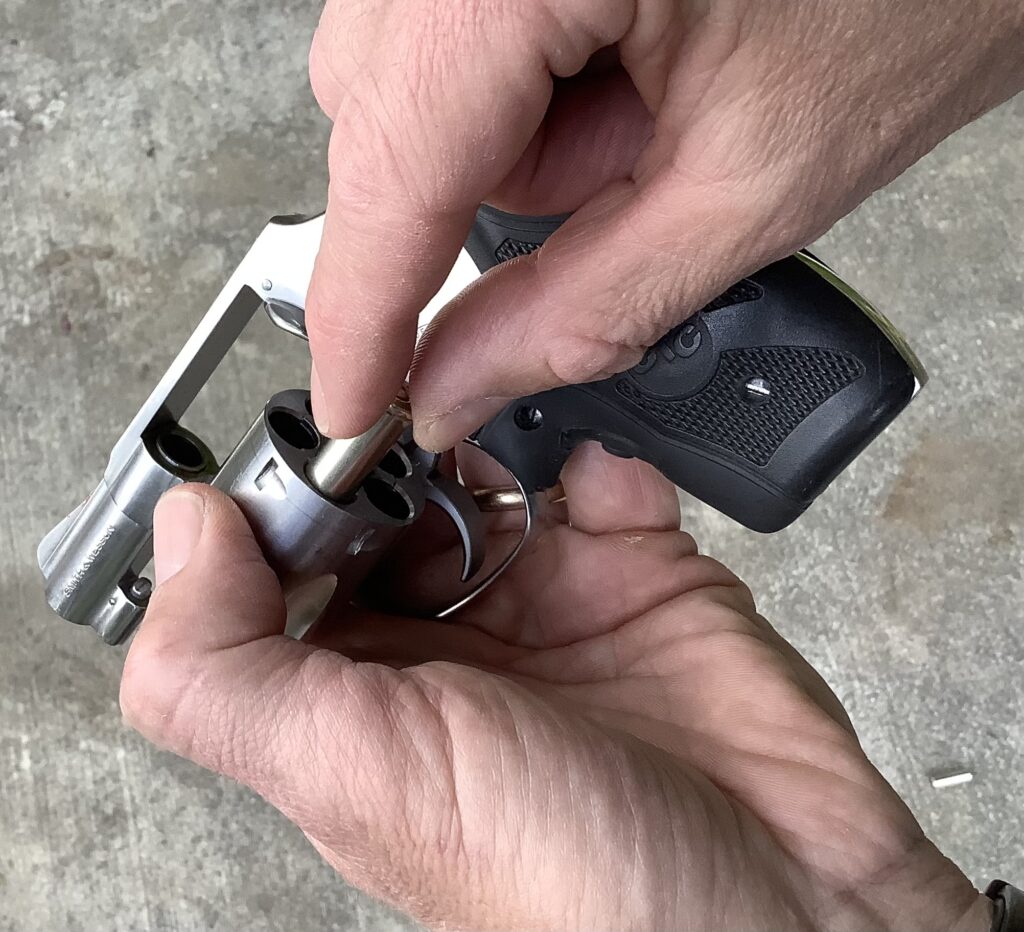
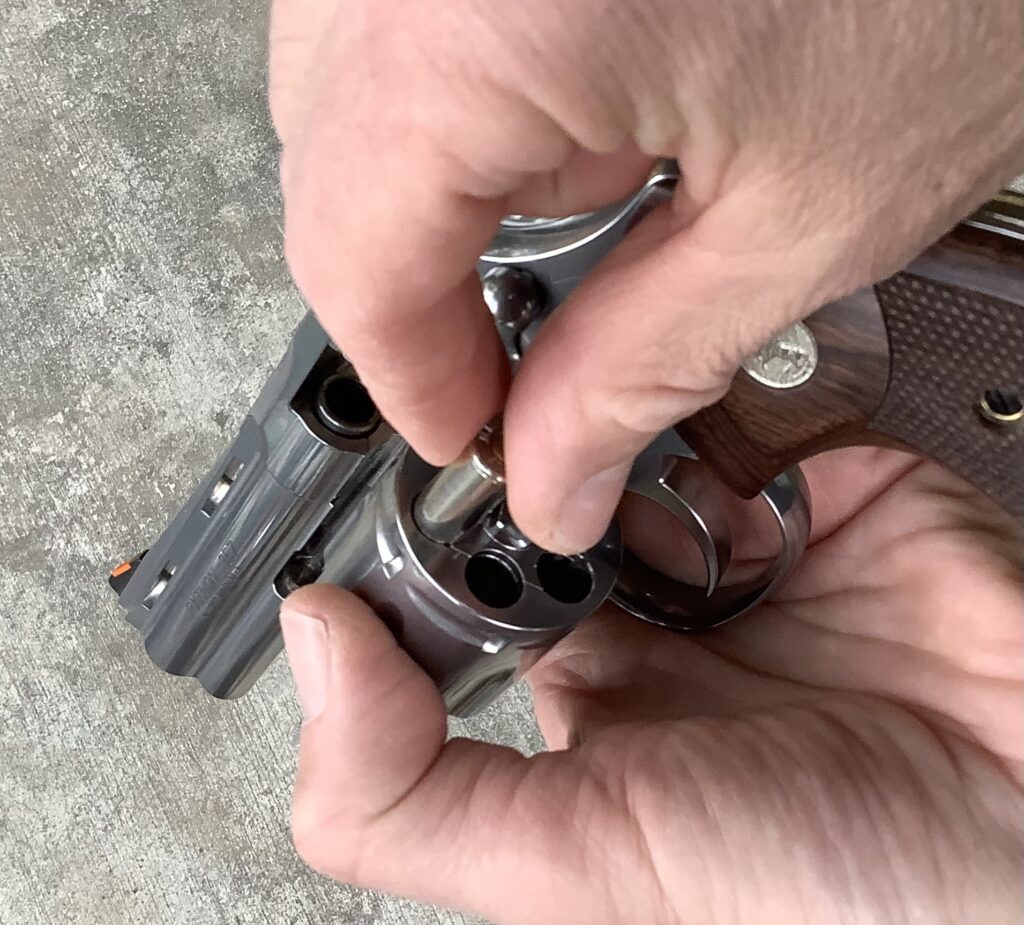
The same process works with a strip loader, if you’re using one of those.4 The thumb or finger that rides on the back of the strip loader is placed in the middle of a pair of cartridges, and you simply mate it with the support hand thumb that’s riding on the cylinder flute or flat. If you don’t strike the chambers directly, you’ll be close, and it will only take a little adjustment to find them.
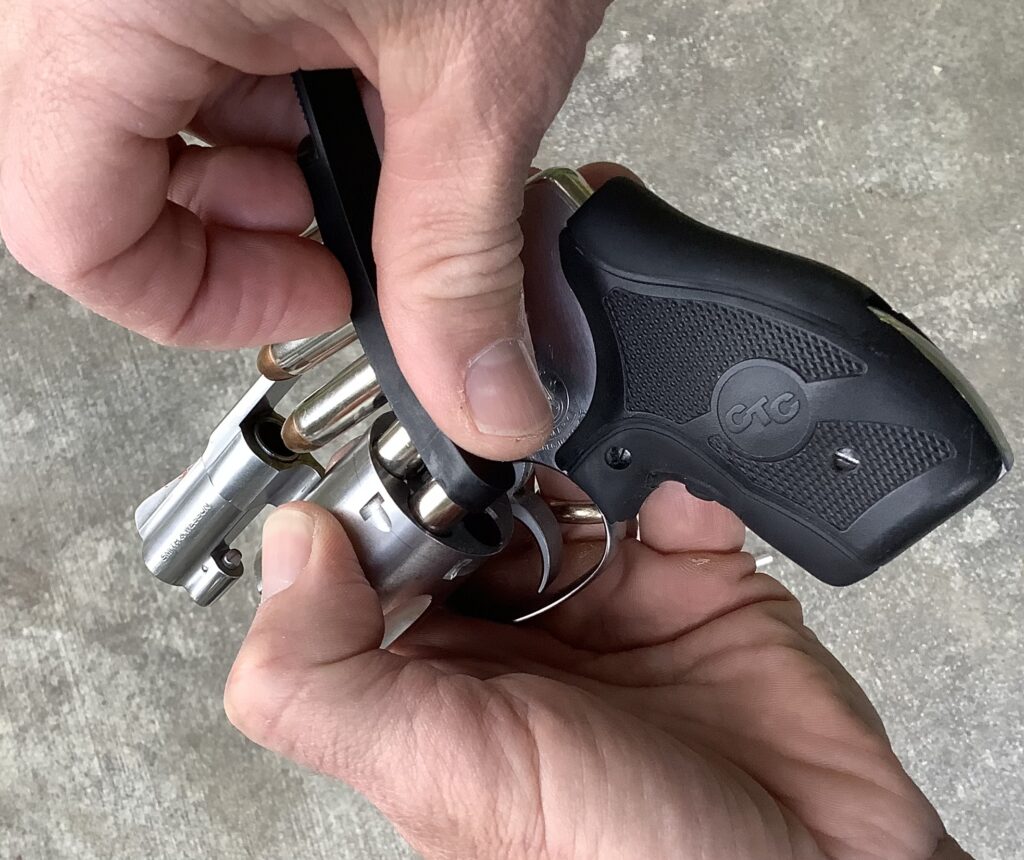
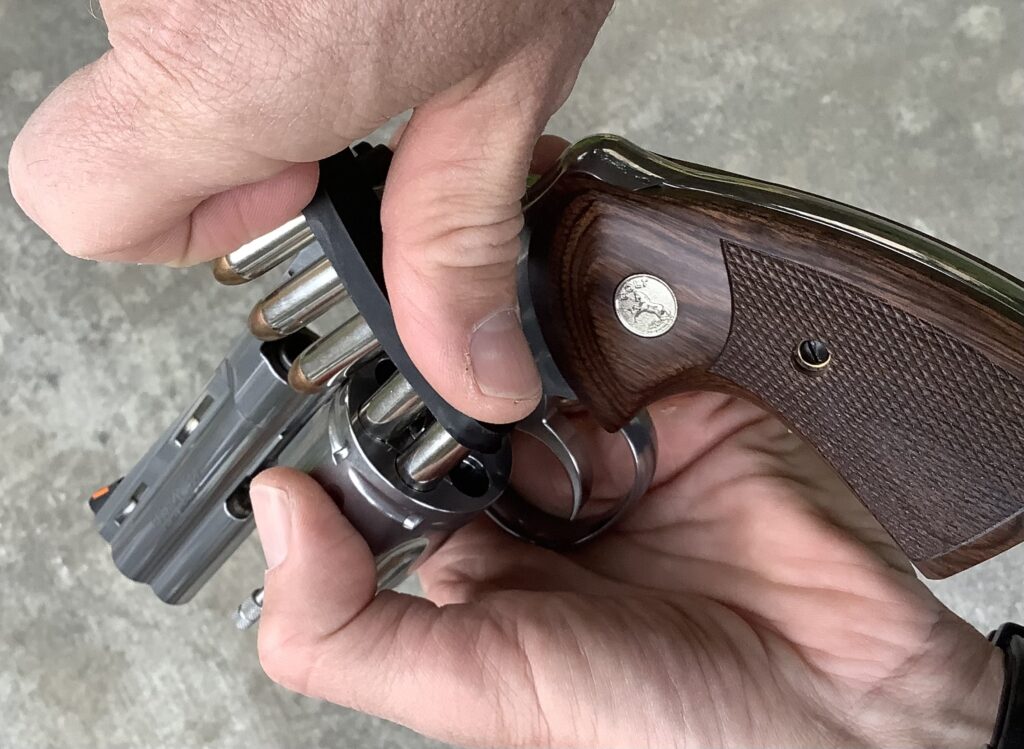
This loading process can be tweaked for a left-handed shooter, too, even though the hold on the gun is different. If you hold the gun in your right hand, with your right hand thumb poking through the cylinder window from right-to-left, you might be able to rest your thumb on the cylinder in that 10 O’Clock region if you have a long thumb, or a small gun. If so, the technique works the same. If your thumb is a little short, and can’t reach to the outside chambers, you can aim the loading hand fingertips at the tip of the thumb, or just outside of it, to find the sweet spot.
If you’re a Lefty and you prefer the Stressfire technique, it’s much the same. A long thumb will still be able to park around 10 O’Clock, and a shorter one will be a little shy of it. Adjust the aim point accordingly, or target one of the support hand fingertips, instead of the thumb.
Rollin’
Okay, so we’ve got two loaded chambers, and it’s time to close the cylinder up. How do we do that, to ensure the first trigger pull results in a “Bang?”
For revolvers that rotate the cylinder counter-clockwise (S&W, Ruger, Kimber, etc.), you’ll want to roll the cylinder clockwise, as it is closed into the gun, to position the loaded chambers to the right of the hammer. The ideal position will place the topmost round in the 1 O’Clock position, so that the very first trigger pull will move it under the hammer, but if you roll the cylinder too far and get one empty chamber in front of it, you’ll just have to click through that chamber to get to the live rounds. At least you won’t have to do it a bunch of times.
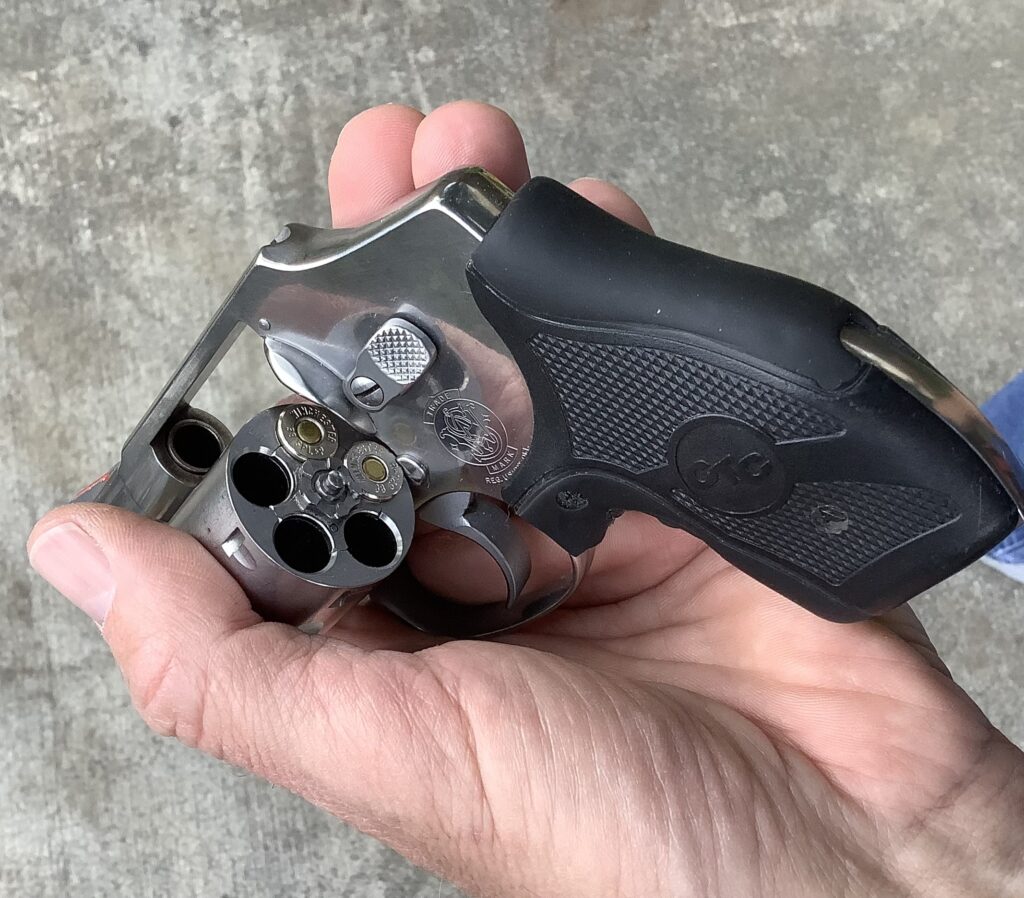
When you roll the cylinder, keep it under control with the thumb and fingers of the hand that is closing it. You don’t want to spin it and let it go, because there’s no telling where the loaded chambers will end up, and it may also damage your gun. But if you keep the cylinder under control, you can put the loaded chambers where you want them to be.
For revolvers that rotate the cylinder clockwise (Colt, M&P Bodyguard .38, etc.), you’ll want to roll the cylinder just a hair counter-clockwise, to keep the loaded chambers to the left of the hammer. You’re essentially trying to keep the loaded chambers where they are, in space, before the crane starts closing into the gun. The ideal position will place the topmost round in the 11 O’Clock position, so that it will fire with the first trigger pull.
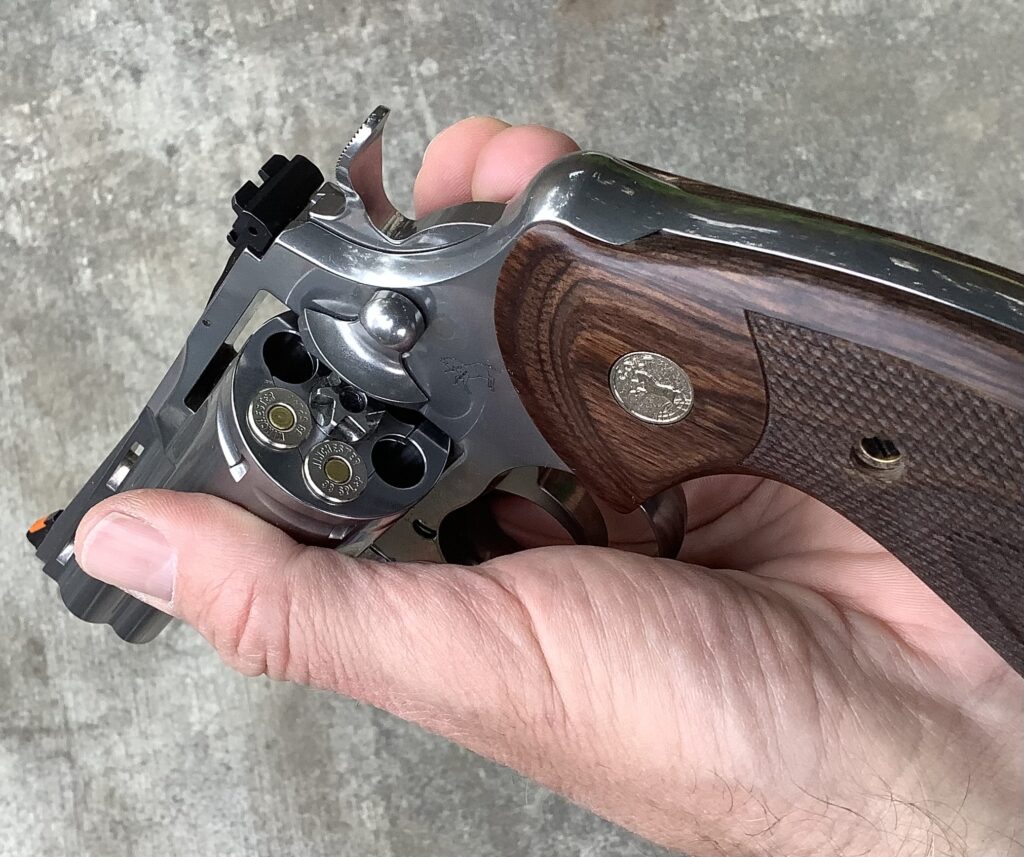
It may help some folks to think about “closing the gun onto the cylinder,” rather than “closing the cylinder into the gun,” as a way to envision parking the cylinder with the loaded chambers in the right place. If that mental trick works for you, then great, but do whatever you need to do, in order to make sure the loaded chambers are set on the proper side of the gun when the cylinder is closed up.
REPEAT, AS REQUIRED
Hopefully, you’ll be able to terminate the hostilities after this first partial load, but in the event more rounds are needed, you’ll just repeat the whole process again. Load two, shoot two. Load two, shoot two, until you win the fight.
If, by chance, you wind up in that uncommon “lull in the fight,” then take advantage of the time to top off your gun with additional rounds–do that proactive, “tactical” reload to fill the tank.5
Your fight will be a bit of an anomaly if you have the time to do a revolver reload of any sort, midstream, but you must be prepared to do it efficiently if the circumstances demand it. Hopefully some of the things we discussed here will aid you in that quest.
Keep your head up, your eyes moving, your ears listening, and be safe out there.
*****
Train with revolverguy!
Attention RevolverGuys! Mike will be teaching a one-day, Defensive Revolver class in Northern California, at the end of October, under the LMS Defense banner. If you’re interested in attending, please check out the course description here. It would be neat to have some readers in the class!
Endnotes
-
- We’ve talked about this before, but the history of armed citizen shootings indicates that opportunities to complete an in-fight reload–and particularly an in-fight revolver reload–will likely be rare. I know better than to use the word never, because Murphy lurks around every corner, but we just don’t see many armed citizens reload their guns during gunfights. For that matter, we don’t see a lot of police officers reload their guns during gunfights, either. It certainly happens (perhaps increasingly so, as fire discipline seems to be more frequently ignored by police, these days), but most police gunfights tend to be settled before reloads are required. Not always, but usually. I think the whole “lull in the fight” concept is more useful in the context of extended military battles than it is in personal defense scenarios, which tend to run to completion without significant pauses in the action;
- Of course, it would be nice to skip loading altogether, but we don’t always have immediate access to a second, loaded gun. If you do, then that may be a better alternative to reloading in extremis;
- Three live rounds from Agent Hanlon’s pouch were found loose on the ground at his position, and the pouch was found with one live round left in it. Hanlon was busy loading these loose rounds when he was shot in the hand, sustaining a severe injury that prevented him from continuing. He was shot again, momentarily;
- It also works nicely with a round-body loader, too. Lay an index finger between two adjoining cartridges in the loader, and mate your index finger to the support hand thumb. Voila!
- The same goes for that chaotic time after the shooting stops. If the bad guys are no longer on the field, get your gun up to full capacity as part of your post-shooting checklist, which should also include other important tasks like seeking cover or a better position, communicating with partners, suspects, witnesses and 911, checking yourself for injuries, and so forth.

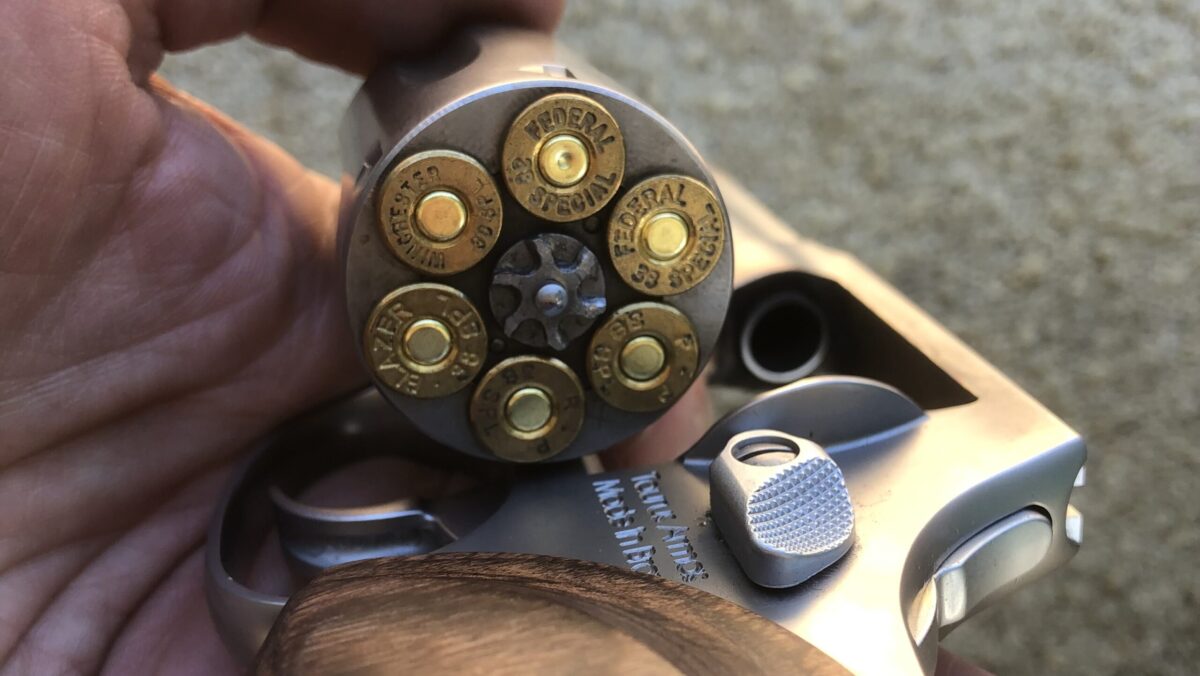
Wish I could train with you Sir! Perhaps another time…?
I’m glad to see your explanation of how to look at the cylinder to see which way it rotates. I’ve taught several people this method, never seen it codified before. Beats trying to come up with a mnemonic or acronym or something:”Colts are counter because they’re clockwise” seems like a bad idea. As to the partial reload, I think it’s great if the fight is OVER. I’m picturing the beginning of John Carpenter’s version of The Thing… Otherwise just speed load if possible.
Just my $.02, never having reloaded in the fight.
I look forward to shooting with you on the range someday, Riley.
So, you made me go look for that movie scene, and now I’ve got to watch the rest of the movie. I missed that one, previously!
Most folks only shoot one type of revolver, so we don’t need to make it complicated for them, but the stop notch trick works pretty good as a reminder.
One of my favorite films 👍! Sadly, I’m not shooting all that well any more, as my eyesight goes to pot… but I’d do my best if we get the opportunity, thanks.
Couldn’t agree more with your observations about the “tactical reload” Mike. It’s always felt like a pretty far-fetched option to me, especially in the ‘heat of the moment’ under stress.
Glad to have the backup, Hammer. Thanks!
I used to know guys who claimed they could “fire two, load two, fire two [from, load two [from 2x2x2 pouches], all day long,” but none of them had ever done it for real, and it always seemed pretty far-fetched to me. (They used this as an argument against changing over from revolvers to autos.)
Like you, I’ve decided that the way to reload a revolver is with speedloaders, and the idea of one-or-two-at-a-time reloading in a gunfight is pretty fanciful. And I’ve had extensive practice with both methods. (But never, I have to say, in a fight.)
I know a lot of trainers teach loading from strip reloaders, and a lot of people carry their reloads that way because they think speedloaders are too bulky to carry, but I can’t agree with either idea. Even though I respect the trainers, I think they’re spending too much time teaching something that probably won’t work in a for-real fight, and I also think that if a speedloader is too bulky to carry, then so is the revolver you plan to reload with it.
I say, speedloaders for the win. And I hope that neither you or I never have to test out theories.
Agreed! Here’s to it remaining a theoretical exercise!
I’ve seen some pretty impressive reloading performances with 2X’s, strips, etc., but I’m not capable of them. I’ll stick with a round body speedloader as much as I can, and save the strips for those times that I can’t find a good way to carry the HKS.
Longtime reader, first-time commenter. Love this site and its content. This article is no exception. I always knew a “tactical reload” was a tall order with a revolver, and this thoughtful analysis has confirmed it to be even more complicated and fraught than I realized. Thank you for all the work that went in to this piece. I appreciate the so-called “New York reload” a lot more now!
Marco, it’s great to hear from you! A second gun is definitely the best reload, sometimes.
Glad you enjoyed the article. Stay safe out there.
Thank you for this column. It speaks to one of my training needs.
It was not two-legged trouble, but I had to open the cylinder on my Kimber when I shot a Copperhead. I’ve had bad luck with CCI snake shot in short-barreled guns. The capsules creep out under recoil and will lock up the gun after a single shot.
In this case, the snake was fleeing our hen-yard and got into tall grass. I shot where I saw movement but it was hardly aimed fire, more point-shooting. I wanted a second shot and the gun had locked up.
Mr. No-legs was angry at being shot and decided to come right at me. I’ve dealt with Copperheads enough not to panic, so I stepped back, opened the cylinder, and pushed in the capsules. A second shot ended the encounter.
After disposing of the snake, I thought about tactical reloads in a human encounter, when I might not have the luxury of fighting a foe who needed to get really close to hurt me. It’s sobering and I need to train more for that.
Another reason to go with moon clips for a revolver. Dump the empty’s along with the remaining live rounds on the ground and plunge in your reload all at once. The Ruger LCR in 9mm is super fast to reload. Protect the moon clip in a speed loader pouch or carry it a plastic 35mm film canister in your pocket, snap off the lid with your thumb (in pocket) and dump the rounds out. Or alternately carry the moon clip naked in your pocket but inspect every day for a bent clip. Or carry two guns . . .
Brett, my mileage with the OEM clips for the LCR is that they definitely need to be protected in some kind of carrier. Your film canister idea is a good solution.
The “two-gun solution”, aka the New York Reload, might be the best option for a lot of folks.
When the proverbial brownie mix (pre baked, of course) collides at relative speed with the spinning turbine blades of the moment, one is going to default to their LOWEST level of training.
Allow me to paraphrase from Flashback City what every person who is dedicated to the revolver ought to understand: This is my revolver. There are many like it, but this one is mine. My revolver is my best friend. It is my life. I must master it as I must master my life. My revolver without me is useless. Without my revolver, I am useless. I must fire my revolver true. I must shoot straighter than the perp who is trying to kill me . . . (skipping some here) . . . My revolver is human, even as I. Because it is my life I will learn it as a brother (or sister as the case might be). I will learn its weaknesses and its strength, its cylinder, barrel, cylinder latch, ejector, extractor, its sights and its trigger. I will keep my revolver clean and ready even as I am clean and ready (most of the time). We will become part of each other.
If you want to really see how you’ll perform under an elevated degree of stress, find a venue that has regular IPSC matches. No, not IDPA — IPSC; International Practical Shooting Confederation. Take your revolver and support gear with at least a dozen speed loading devices of your choice along with plenty of ammo.
After you’ve shot a complete day of courses of fire, and you’ve located all your empty loading devices, then you can evaluate things on a more serious level. How well could you coordinate your reloads? How many did you fumble? How long did it take you . . . not how long you thought it took you. How well were you able to recover from the reloading and get back on target?
(kinda sorta) Long before IDPA came along, I regularly shot IPSC matches with my old duty rig, and alternating between my S&W Model 66, and my Colt Mk III Trooper. IPSC major power factor mandated I shoot full power .357 rounds. Courses of fire could be up to 40 rounds or more, so divide that by 6 round speed loaders, and you find yourself with loaders on your belt, your vest pockets and sometimes pants pockets. (You quickly find out how wrong chair-borne commandos are.)
When you’re the only revolver shooter over the course of several years among 20-plus shooters using uber-high capacity race guns with compensators and red dot sights, it is humbling, yet very challenging for one to get their skills finely tuned. You either become highly proficient, or you drop down to IDPA.
I used two opposite functioning platforms – The clockwise Colt vs the counter-clockwise S&W – because I loved both guns and could never really make up my mind which one was going to be THE predominant one; AND, because Newhall was still rather fresh in our academy. Our department had a mix of Colt and S&W revolvers, and it was strongly suggested to me by an academy instructor with Sergeant’s stripes and enough service bars to decorate a Christmas Tree that I get real familiar with both, you know, Just In Case.
The revolver as a primary duty sidearm eventually gave way to the bottom feeder, and while I carried that as the mandated sidearm, the J-Frame S&W was and remains my life insurance policy for when that brownie mix goes flying out of Murphy’s Kitchen.
Mike can certainly tell you that what you think will work does not always work, and what you didn’t think would work sometimes works out better than you thought. In the process of hands on over time, you get to learn your revolver as a Marine learns his Rifle !
I want you to know I read the “My Revolver” bit while standing at Port Arms! 😁
Thank you for the great testimony to the power of realistic training. There’s so much silliness that passes for “training” in agencies and the public arena these days . . . when you get right down to it though, good training is mostly about doing the basics in the proper context.
I actually shot against some guys at the club today, armed with my revolver. They had optic-equipped autos and it was a particularly lopsided contest on the stages that required reloading, but I held my own on the draw to a good first hit, even with crappy sights. The experience gave me a chance to stress test my skills and see where I need to improve, which is what it’s all about.
Walt Rauch used to say that gun guys “Talked .45s, shot 9mms, and carried snub .38s.” That sounds like a recipe for failure, in my book. Train with the gear you actually carry, and it will pay dividends.
I wish I could attend your revolver training in Sacramento next month, but as I write this I’m helping my son’s family in Annapolis and watching midshipmen sailing on Chesapeake Bay, some 2,746 miles away.
If my memory serves me well, my department briefly touched on tactical reloading of a revolver. Range personnel would advise, “If there’s a lull in the fire fight, dump out all rounds – spent and live- then load two, look up, load two, look up… don’t bury your head in the gun.”
Instructors reminded us to be ready to close the cylinder and fire however many rounds you were able to load in case your opponent advanced upon your position.
The “load two mantra” was in the dump pouch era, prior to the authorization of speed loaders.
Thanks again for your comprehensive article of P.O. Gadell’s sacrifice. A few weeks after his line of duty death, all officers were finally allowed to purchase speed loaders without fear of disciplinary action for unauthorized equipment.
As you may recall, some renegade street cops in the outer boroughs had previously chosen to wear speed loaders and/or ammo held in leather loops. Fear of armed perps outweighed fear of the Brass in One P P.
Carrying a second revolver was actively encouraged by the Firearms & Tactics Section. Clearly that was sound advice and easier to utilize in combat than trying a seldom practiced technique of partially unloading spent cases from a revolver, then topping it off with live rounds.
The unused live rounds from a dump pouch would likely land on the pavement since all six rounds fell out simultaneously.
Pretty difficult to repackage them in a pouch, especially at night, in the rain, while laying in a gutter as someone is firing at you.
Keep these articles coming.
They are greatly appreciated!
Thank you Sir! I’d love to have all the RevolverGuy crowd on the range together, but you have 2,746 good reasons not to be there. 😁
Thanks again for sharing your insight about police training and operations in the revolver era. There are a lot of important lessons from that time that we don’t want to forget—lessons that were learned the hard way, and paid for in blood, sweat, and tears.
I’m grateful we’ve advanced past dump pouches for duty use, but the dump pouch and speed strip reloads have some commonalities we can’t ignore, and there’s still a lot of people carrying strips these days. “Load two and look up” is still good advice for RevolverGuys, today.
This is a really great, in-depth, useful article. I was trained on the “tactical” revolver reload at the Border Patrol Academy. Ironically, while I used speedloaders when I subsequently packeted a wheel gun, I never used the technique nor even needed it for qualification, until…. Fast forward 30 years and i qualify with a revolver to accompany my self loader at annual LEOSA quals. The course was designed for semis, still has no set reload stages, and all strings are 3-4 rounds until the. 25. Thus I’ve used the “tactical” to stay topped off before holstering for the next string. It works for that and mystifies the range masters who were born after my 1987 vintage Model 36 was forged.
Haha! All those square-gun guys start looking like the Victrola Dog once the round guns come out, huh Rob? (They probably don’t know who the Victrola Dog is, either–we’ll have to give them a break, since a lot of them missed the 1900s).
I thought snubs were only good for phone booths? They actually shoot as far as 25 yards? ; ^ ) Attaboy! Show ’em how it’s done!
Glad you liked the article, and thank you for your prior service on the border, back when we still had one.
Those of us who practice Historical European Martial Arts (HEMA) (think Medieval and Renaissance sword – dagger – spear – grappling -etc) have a lot conversations about realism, scenarios, training artifacts, sporting artifacts – all really just discussions about context. There are well-documented techniques with for longswords that never happen in modern longsword tournaments, because they don’t work correctly with training swords (the bind of two sharp edges is very different than two blunt edges). Practitioners who care about the art learn and practice these techniques, but people who are solely focused on competition don’t waste valuable training time on them. Modern sport fencing (like you see in the Olympics) evolved out of classical dueling combat, but includes things (like whipover) that simply can’t happen with sharp swords. The sword art I practice is all about dueling and self-defense (16th century style), which is very different than, say, battlefield combat in the same time period. Context should drive training – but a person can be interested in more than one context.
Which finally brings me back around to the revolver. Fast reloads are important in a few contexts: police work (if there are any cops still using revolvers!); competition; training classes (to keep things moving); and probably a few others I’m not thinking of at the moment. I’m not sure I think that my primary reason for having the revolver (civilian defensive use) actually requires fast reloads – I have yet to see any reference anywhere that a civilian has ever needed a fast reload (or any reload) during a fight. So this is pretty low on my list of training priorities, but that doesn’t mean I don’t practice it all. For example, I want to take a few classes over the next year or two (signed up for Mike’s Sacramento class already!) and having at least a low level of ability with the speedloader just seems like it will help the class flow better.
TLDR; I tend to think of reloading is probably entirely irrelevant to my civilian defensive needs, but still worth pursing for me, at least a little bit, since it is part of the total art of the revolver.
When I went through the academy 34 years ago the rangemaster told us which way the cylinder or a colt or smith (the revolvers we could carry) rotated in case we needed to do a partial reload. That ended partial reload training. I learned the 2x2x2 by watching an older guy at qualification when I forgot to bring the speed loaders for my back up gun. It worked well for me though.
It’s kind of cool to see names put to techniques I’ve seen over the years. It makes it seem like we weren’t just making it up.
You’re doing a great job Mike. Keep it up.
Thank you BC! I bet you remembered the speedloaders next time, eh? 😁
Another excellent article, Mike! While I recuperate from surgery to my right shoulder I’m running my 640-1 Pro-Series left-handed, weak-hand only (using techniques you discussed in RG305). I’ve become a fan of the Original Precision moon clips which eject my first cylinder of empties positively when pressing the ejector with only my left thumb. I’m using JetLoaders for the recharge until I can incorporate my right hand into my left-handed recharge (RG101). At that point I’ll see about going back to my usual spare ammo solution, an eight-round Tuff QuickStrip loaded 2-0-2-0-2 to facilitate partial reloads. Long story short, no “tactical reloads”; full or partial, if there’s time… PS Thank you for your informative writing which has kept this old man armed and on the firing line.
Michael, hang in there with the recovery! When I had my left shoulder rebuilt, it seemed like it would take forever to get out of that sling. It’s worth all the effort though—you’ll be much happier when it all heals up.
My 640 was my constant companion during that time, too. It’s not cut for clips though, and I think you’ve got an advantage with yours. Sounds like you’ve got a good plan for how to recharge it, too.
I’m happy we’ve been able to help with our past articles! We’ve assembled a pretty good library now, with lots of good reference material, and it makes me happy to hear it’s being used.
Hang in there, heal fast, and stay safe!
Mike,
Was pleased to see your article in Greg Ellifritz’ “Weekend Knowledge Dump” today. I immediately clicked on the link, of course.
Your descriptions of different reload methods, along with photos was really good. I’m shooting a Ruger LCR with .38sp ammo.
Last November I was at the Revolver Roundup at Gunsite. Greg was teaching a class on reloading. For the wheelgun folks, he reviewed and demonstrated both the speedloaders and speed strips. I have both. A few years ago, Greg discussed in an article the use of speed strips, and the various ways they can be loaded. He recommended the 8-round speed strip that Tuff Products carries. I ordered two so I would have them for carry purposes.
In the class, we practiced loading the speed strips with the rounds in different layouts. I ended up liked the one Greg demonstrated, as you suggested, in the 2x2x2, but with the advantage of having one empty hole/space between the middle 2 rounds and the 2 end rounds. We did practice partial reloads, with Greg timing us. I did the partial 2-round reload fastest with the 2x2x2x with the empty holes/spaces.
I checked on the class you are teaching in Sacramento in October. 1 seat left. Yikes! Not sure if I can squeeze that trip in with the increased gas prices. Haven’t checked airline prices. Please check with your wife and see if she has an opening in your guest room. LOL Kidding!!! I have family in Sacrament0 if I decide I can fit your class in.
Thanks for this great article, Mke.
WGJ